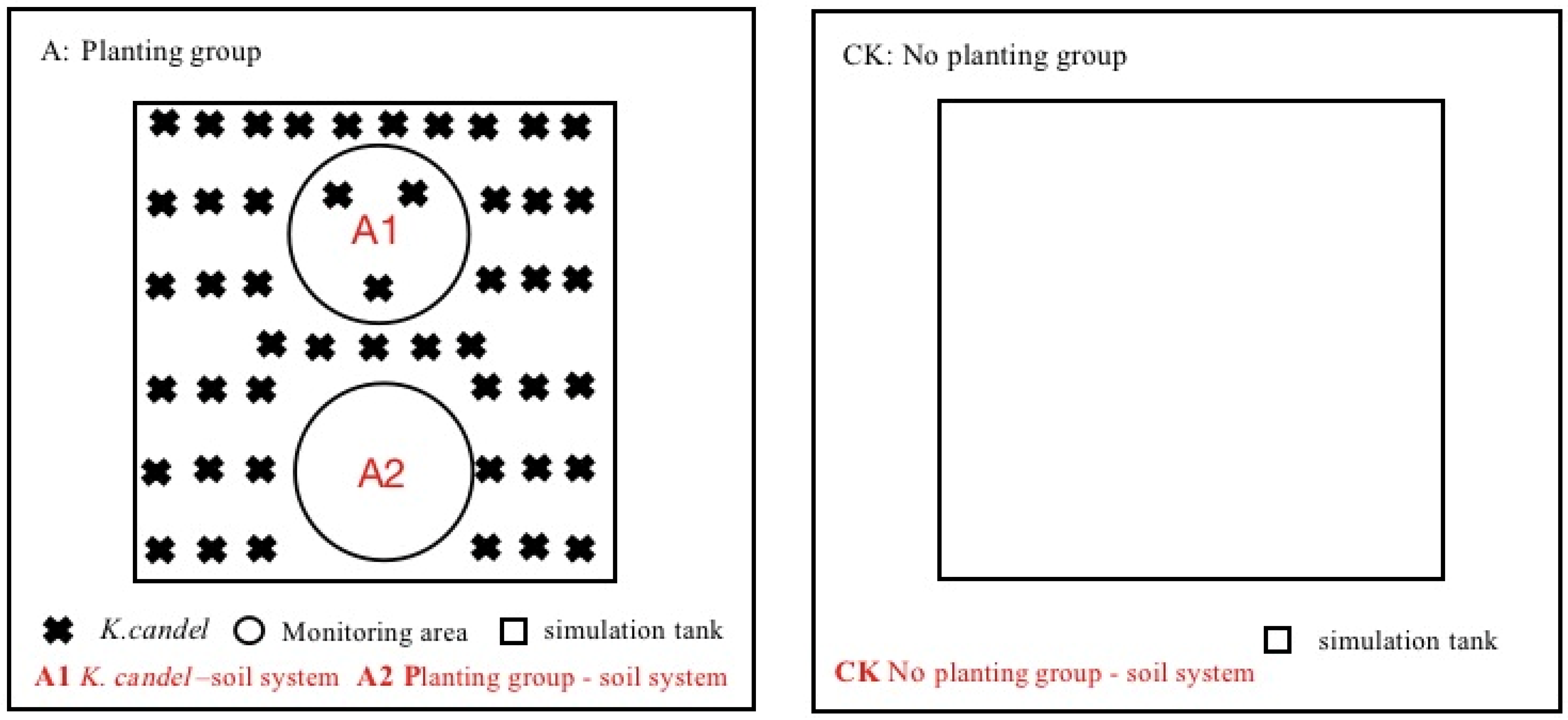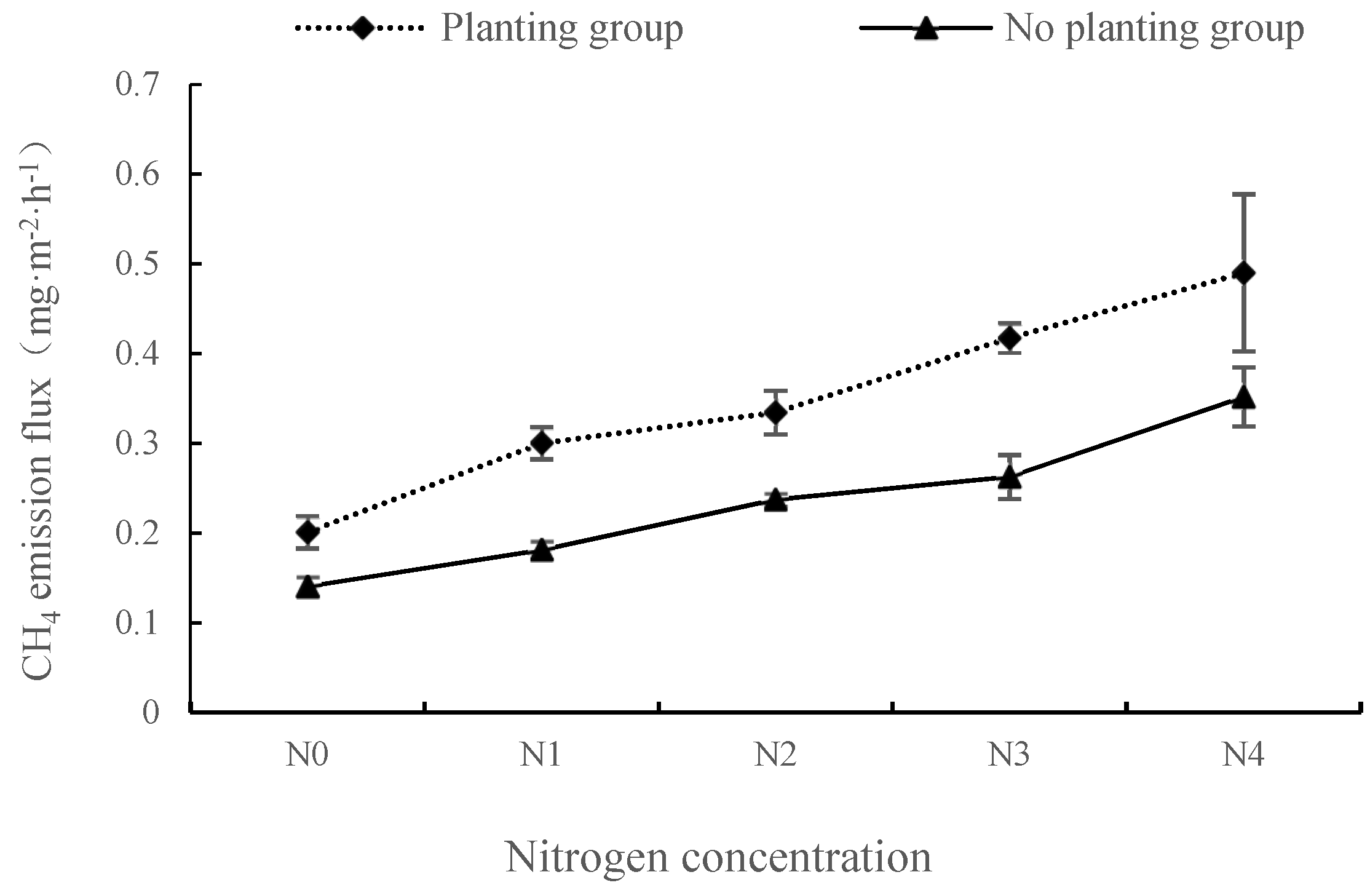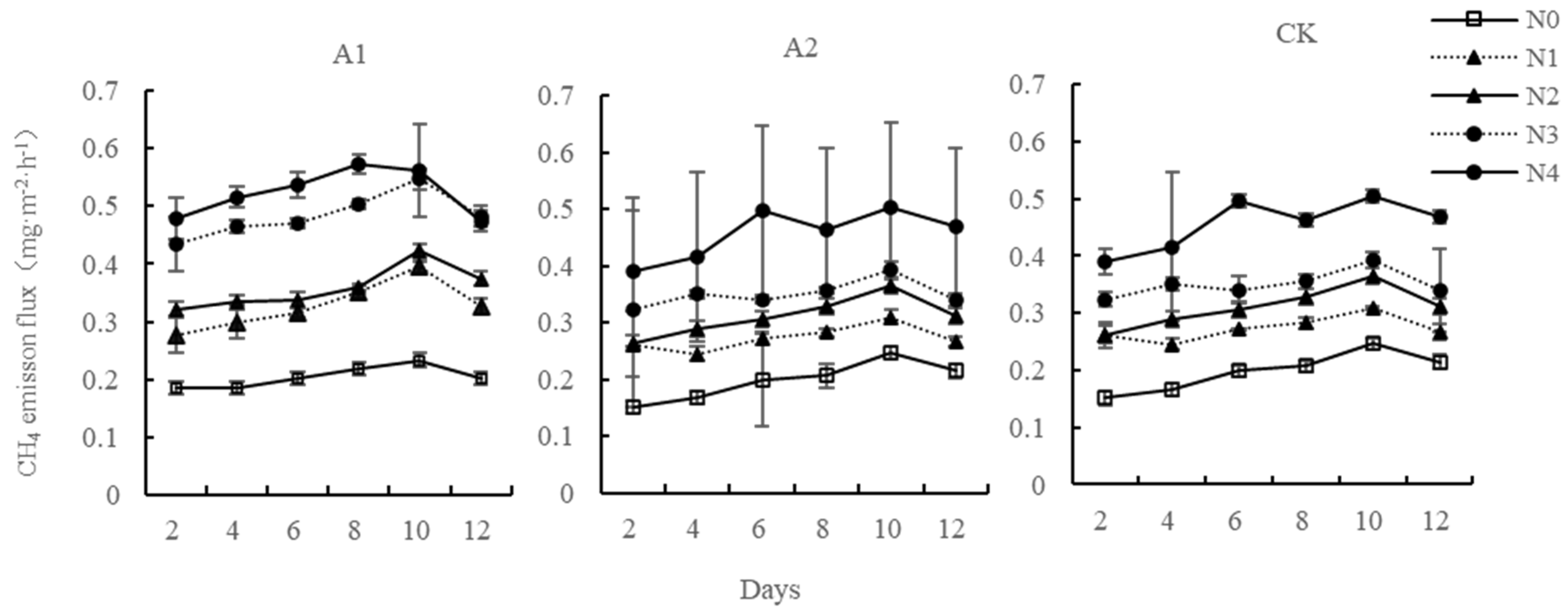Methane Contributions of Different Components of Kandelia candel–Soil System under Nitrogen Supplementation
Abstract
:1. Introduction
2. Materials and Methods
2.1. Tidal Simulation Experiment
2.2. Culture Medium, Kandelia candel Nursery and Nitrogen Treatment
2.3. Gas Collection, Measurement, and Calculation
3. Results
3.1. The Impact of Kandelia candel on Coastal Wetland CH4 Emissions
3.2. CH4 Emission Rules of Different Systems
3.3. The CH4 Emission Contribution of Kandelia candel and Microorganisms under Nitrogen Addition
3.4. Environmental Factors Analysis
4. Discussion
4.1. Kandelia candel Promotes CH4 Emissions from Coastal Wetland Ecosystems
4.2. Nitrogen Addition Promotes CH4 Emission Fluxes
4.3. Kandelia candel and Soil Microorganisms CH4 Emission Fluxes
4.4. The Relationship between CH4 Emission Fluxes and Its Impacting Factors
5. Conclusions
Author Contributions
Funding
Institutional Review Board Statement
Informed Consent Statement
Data Availability Statement
Conflicts of Interest
References
- Hu, M.; Tong, C. Effects of nitrogen enrichment on the greenhouse gas fluxes in natural wetlands and the associated mechanism: A review. Chin. J. Ecol. 2014, 33, 1969–1976. [Google Scholar]
- Guirui, Y. Global Change and Carbon Cycle and Carbon Storage in Terrestrial Ecosystem; China Meteorological Press: Beijing, China, 2003. [Google Scholar]
- Segers, R. Methane production and methane consumption: A review of processes underlying wetland methane fluxes. Biogeochemistry 1998, 41, 23–51. [Google Scholar] [CrossRef]
- Gu, H.; Xiao, F.; He, Z.; Yan, Q. Microbial-mediated methane emission mechanisms in wetlands. Acta Microbiol. Sin. 2018, 58, 618–632. [Google Scholar]
- Saarnio, S.; Saarinen, T.I.M.O.; Vasander, H.; Silvola, J. A moderate increase in the annual CH4 efflux by raised CO2 or NH4NO3 supply in a Boreal oligotrophic mire. Glob. Chang. Biol. 2001, 6, 137–144. [Google Scholar] [CrossRef]
- Rosentreter, J.A.; Borges, A.V.; Deemer, B.R.; Holgerson, M.A.; Liu, S.; Song, C.; Melack, J.; Raymond, P.A.; Duarte, C.M.; Allen, G.H. Half of global methane emissions come from highly variable aquatic ecosystem sources. Nat. Geosci. 2021, 14, 225–230. [Google Scholar] [CrossRef]
- Tao, B.; Chen, Y. Effects of nitrogen forms on the stability of soil organic carbon in wetlands: A review. Ecol. Environ. Sci. 2016, 25, 162–167. [Google Scholar]
- Quanzhou Environmental Protection Bureau. 2017 Quanzhou Environmental Quality Bulletin; Quanzhou Environmental Protection Bureau: Guangzhou, China, 2017.
- Li, D. Effects of Simulated Nitrogen Deposition on CO2 and CH4 Emissions from Freshwater and Brackish Marshes in the Min River Estuary; Fujian Normal University: Fuzhou, China, 2018. [Google Scholar]
- Liu, X.M.; Gao, T.T.; Zhang, Z.J.; Tan, K.X.; Jin, Y.B.; Zhao, Y.J.; Chao, L.I. The mitigation effects of exogenous dopamine on low nitrogen stress in Malus hupehensis. J. Integr. Agric. 2020, 19, 2709–2724. [Google Scholar] [CrossRef]
- Mou, X. Response of Key Processes of Carbon and Nitrogen Cycle to Nitrogen Addition in the Min River Estuarine Wetland; Graduate School of Chinese Academy of Sciences (Northeast Institute of Geography and Agroecology): Beijing, China, 2013. [Google Scholar]
- Li, R.; Chang, R. Effect of external nitrogen additions on soil organic carbon dynamics and the mechanism. Chin. J. Plant Ecol. 2015, 39, 1012–1020. [Google Scholar]
- Mou, X.; Liu, X.; Tong, C.; Sun, Z. Responses of CH4 emissions to nitrogen addition and Spartina alterniflora invasion in Minjiang River estuary, southeast of China. Chin. Geogr. Sci. 2014, 24, 562–574. [Google Scholar] [CrossRef] [Green Version]
- Ministry of Ecology and Environment of the People’s Republic of China. 2020 Bulletin on the State of China’s Marine Ecological Environment; Ministry of Ecology and Environment of the People’s Republic of China: Beijing, China, 2021.
- Zheng, K.Z.; Chen, G.; Zheng, X.W.; Chen, G.Z. Wastewater treatment with constructed mangrove wetland system: A review. Chin. J. Ecol. 2009, 28, 138–145. [Google Scholar]
- Song, C.C.; Wang, Y.Y.; Wang, Y.S.; Zhao, Z.C. Dynamics of CO2, CH4 and N2O emission fluxes from mires during freezing an thawing season. Environ. Sci. 2005, 26, 7–12. [Google Scholar]
- Granberg, Q.; Sundh, I.; Svensson, B.H.; Nilsson, M. Effects of temperature, and nitrogen and sulfur deposition, on methane emission from a Boreal Mire. Ecology 2001, 82, 1982–1998. [Google Scholar] [CrossRef]
- Zeng, C.; Wang, W.; Tong, C. Effects of different exogenous electron acceptors and salt import on methane production potential of estuarine marsh soil. Geogr. Res. 2008, 25, 1321–1330. [Google Scholar]
- Cai, Z.; Xing, G.; Yan, X.; Xu, H.; Tsuruta, H.; Yagi, K.; Minami, K. Methane and nitrous oxide emissions from rice paddy fields as affected by nitrogen fertilisers and water management. Plant Soil 1997, 196, 7–14. [Google Scholar] [CrossRef]
- Fechner, E.J.; Hemond, H.F. Methane transport and oxidation in the unsaturated zone of a Sphagum peatland. Glob. Biogeochem. Cyecles 1992, 6, 33–44. [Google Scholar] [CrossRef]
- Allen, D.E.; Dalal, R.C.; Rennenberg, H.; Meyer, R.L.; Reeves, S.; Schmidt, S. Spatial and temporal variation of nitrous oxide and methane flux between subtropical mangrove sediments and the atmosphere. Soil Biol. Biochem. 2007, 39, 622–631. [Google Scholar] [CrossRef]
- Chen, G.C.; Tam, N.F.Y.; Ye, Y. Summer fluxes of atmospheric greenhouse gases N2O, CH4 and CO2 from mangrove soil in South China. Sci. Total Environ. 2010, 408, 2761–2767. [Google Scholar] [CrossRef]
- Chen, G.C.; Tam, N.F.Y.; Ye, Y. Spatial and seasonal variations of atmospheric N2O and CO2 fluxes from a subtropical mangrove swamp and their relationships with soil characteristics. Soil Biol. Biochem. 2012, 48, 175–181. [Google Scholar] [CrossRef]
- Cui, S. Interrelationship between Methane Dynamics and Environmental Factors in Kandelia candel Mangrove Wetland; Xiamen University: Xiamen, China, 1998. [Google Scholar]
- Lu, C.Y.; Ye, Y.; Huang, Y.S.; Tan, F.Y. Methane flux of mangrove communities in Niaodongzhai Harbor, Hainan. Acta Microbiol. Sin. 2000, 24, 87–90. [Google Scholar]
- Lu, C.Y.; Jin, L.; Ye, Y.; Ye, G.F. Diurnal variation of soil respiration and its temperature sensitivity in Kandelia candel mangrove wetland. J. Xiamen Univ. (Nat. Sci.) 2012, 51, 793–797. [Google Scholar]
- Gao, C.; Hu, J.; Yan, K.; Xin, K. Carbon dioxide and methane emission fluxes from soil in mangrove forest in Dongzhaigang, Hainan. Wetl. Sci. 2017, 15, 7. [Google Scholar]
- Zhang, Y.; Hu, W.; Luo, M.; Tong, C.; Huang, J. Carbon, nitrogen, and phosphorus dynamics an hydrolytic enzyme activities during foliar litter decomposition of Kandelia candel in a mangrove population of the Min river estuary. Acta Ecol. Sin. 2019, 39, 13. [Google Scholar]
- Chen, K. Methane Emission Flux of Kandelia candel Mangrove Ecosystem in Minjiang Estuary and Its Contribution; Fujian Normal University: Fuzhou, China, 2018. [Google Scholar]
- Terrer, C.; Phillips, R.P.; Hungate, B.A.; Rosende, J.; Pett-Ridge, J.; Craig, M.E.; van Groenigen, K.J.; Keenan, T.F.; Sulman, B.N.; Stocker, B.D.; et al. A trade-off between plant and soil carbon storage under elevated CO2. Nature 2021, 591, 599–603. [Google Scholar] [CrossRef] [PubMed]
- Wang, L.; Pan, D.; Lv, X.; Cheng, C.L.; Li, J.; Liang, W.; Xing, J.; Chen, W. A multilevel investigation to discover why Kandeliacandel thrives in high salinity: Phenylpropanoids and amino acids under salt stress. Plant Cell Environ. 2016, 39, 2486–2497. [Google Scholar] [CrossRef] [PubMed]
- Huang, Q. Atmospheric nitrogen deposition in Xiamen city. Energy Environ. 2018, 1, 63–66. [Google Scholar]
- Liao, J. Analysis of Methane and Carbon Dioxide Emission Flux from Reed Wetland in the Estuary of Minjiang River; Fujian Normal University: Fuzhou, China, 2010. [Google Scholar]
- Zhou, W.; Wang, J.; Liu, J. Study on the relation of plant biomass and CH4, N2O emission in the wetland of Sanjiang Plain. J. Univ. Chin. Acad. Sci. 2006, 23, 736–743. [Google Scholar]
- Chen, H.; Zhou, S.; Wu, N.; Wang, Y.F.; Luo, P.; Shi, F.S. Advance in studies on production, oxidation and emission flux of methane from wetlands. Chin. J. Appl. Environ. Biol. 2006, 12, 726–733. [Google Scholar]
- Hirota, M.; Senga, Y.; Seike, Y.; Nohara, S.; Kunii, H. Fluxes of carbon dioxide, methane and nitrous oxide in two contrastive fringing zones of coastal lagoon, Lake Nakaumi, Japan. Chemosphere 2007, 68, 597–603. [Google Scholar] [CrossRef]
- Jiang, H.; Sun, Z.; Song, H. A preliminary study on methane production potential of soil in tidal wetlands of the Yellow River estuary and its responses to organic matter and nitrogen import. Wetl. Sci. 2012, 10, 451–458. [Google Scholar]
- Hu, M.; Tong, C.; Zou, F. Effects of nitrogen input on CH4 production, oxidation and transport in soils, and mechanisms: A review. Acta Pratacult. Sin. 2015, 24, 204–212. [Google Scholar]
- Wu, L.; Ma, K.; Li, Q.; Ke, X.; Lu, Y. Composition of archaeal community in a paddy field as affected by rice cultivar and N fertilizer. Microb. Ecol. 2009, 58, 819–826. [Google Scholar] [CrossRef] [PubMed]
- Hu, M. Effects of Enrichement of Nitrogen and Sulfate Load on CH4 and CO2 Fluxes from the Cyperus malaccensis Marsh in the Min River Estuary; Fujian Normal University: Fuzhou, China, 2016. [Google Scholar]
- Dai, Z.; Yu, M.; Chen, H.; Zhao, H.; Huang, Y.; Su, W.; Xia, F.; Chang, S.X.; Brookes, P.C.; Dahlgren, R.A.; et al. Elevated temperature shifts soil N cycling from microbial immobilization to enhanced mineralization, nitrification and denitrification across global terrestrial ecosystems. Glob. Chang. Biol. 2020, 26, 5267–5276. [Google Scholar] [CrossRef] [PubMed]
- Song, C.C.; Zhang, L.H.; Wang, Y.Y.; Zhao, Z.C. Annual dynamics of CO2, CH4, N2O emission from freshwater marshes and affected by nitrogen fertilization. Environ. Sci. 2006, 27, 2369–2375. [Google Scholar]
- Joabsson, A.; Christensen, T.R. Methane emissions from wetlands and their relationship with vascular plants: An Arctic example. Glob. Chang. Biol. 2010, 7, 919–932. [Google Scholar] [CrossRef]
- Xu, X.; Zhao, Y.; Zou, X.; Tang, D.; Liu, D. Advances in the research on methane emissions of coastal saline wetlands in China. J. Nat. Resour. 2015, 30, 1594–1605. [Google Scholar]
- Liu, Z. Methane Transport by Reed Wetland Plants in the Estuary of Minjiang River; Fujian Normal University: Fuzhou, China, 2011. [Google Scholar]
- Pangala, S.R.; Moore, S.; Hornibrook, E.R.; Gauci, V. Trees are major conduits for methane egress from tropical forested wetlands. New Phytol. 2013, 197, 524–531. [Google Scholar] [CrossRef]
- Tian, D. Study on CH4 and CO2 Emission Fluxes from Mangrove Soils in Yingluo Harbor, Guangxi; Guangxi Normal University: Guilin, China, 2012. [Google Scholar]
- Wang, Q.; Liu, M.; Hou, L.; Cheng, S. Temporal and spatial differences of CO2, CH4 and N2O emissions in Dongtan Wetland of Chongming. Geogr. Res. 2010, 29, 935–946. [Google Scholar]
- Poffenbarger, H.J.; Needlman, B.A.; Megonigal, J.P. Salinity influence on methane emissions from tidal marshes. Wetlands 2011, 31, 831–842. [Google Scholar] [CrossRef]
- Tremblay, A.; Varfalvy, L.; Garneau, M.; Roehm, C. Greenhouse Gas Emissions-Fluxes and Processes: Hydroelectric Reservoirs and Natural Environments; Apress: New York, NY, USA, 2005; Volume 7, pp. 111–127. [Google Scholar]
- Zhang, Y. Research progress on methane emissions from wetlands. Chin. J. Environ. Eng. 1998, 1, 39–48. [Google Scholar]
- Hao, Q.J.; Wang, Y.S.; Song, C.C.; Liu, G.R.; Wang, Y.Y.; Wang, M.X. Study of CH4 emission from wetlands in Sanjiang Plain. J. Soil Water Conserv. 2004, 18, 194–199. [Google Scholar]




| Volumetric Weight (g/cm3) | TC Content (%) | TN Content (%) | NH4+–N (mg/kg) | NO3–N (mg/kg) |
|---|---|---|---|---|
| 62.72 ± 0.03 | 1.89 ± 0.13 | 0.13 ± 0.0025 | 3.24 ± 0.34 | 2.71 ± 0.12 |
| Nitrogen Concentration | Incubator Temperature (°C) | Soil Temperature (°C) | Soil Salinity (mg/L) | Eh (μs/cm) | R2 | |
|---|---|---|---|---|---|---|
| K. candel planting group | N0 | −0.874 * | −0.788 | −0.447 | 0.277 | 0.4701 |
| N1 | −0.834 * | −0.828 * | −0.334 | −0.101 | 0.5304 | |
| N2 | −0.829 * | −0.853 * | 0.363 | 0.158 | 0.6449 | |
| N3 | −0.830 * | −0.675 | −0.304 | −0.040 | 0.5195 | |
| N4 | −0.835 * | −0.833 * | −0.638 | −0.216 | 0.0372 | |
| Non-planting group | N0 | −0.703 | −0.344 | 0.03 | −0.309 | 0.6865 |
| N1 | −0.725 | −0.630 | −0.503 | −0.423 | 0.7063 | |
| N2 | −0.705 | −0.653 | 0.201 | −0.156 | 0.6773 | |
| N3 | −0.666 | −0.400 | −0.084 | −0.300 | 0.841 | |
| N4 | −0.703 | −0.675 | 0.319 | −0.089 | 0.720 |
Publisher’s Note: MDPI stays neutral with regard to jurisdictional claims in published maps and institutional affiliations. |
© 2022 by the authors. Licensee MDPI, Basel, Switzerland. This article is an open access article distributed under the terms and conditions of the Creative Commons Attribution (CC BY) license (https://creativecommons.org/licenses/by/4.0/).
Share and Cite
Feng, C.; You, H.; Tan, F.; Han, J.; Yu, X.; You, W.; He, D. Methane Contributions of Different Components of Kandelia candel–Soil System under Nitrogen Supplementation. Forests 2022, 13, 318. https://doi.org/10.3390/f13020318
Feng C, You H, Tan F, Han J, Yu X, You W, He D. Methane Contributions of Different Components of Kandelia candel–Soil System under Nitrogen Supplementation. Forests. 2022; 13(2):318. https://doi.org/10.3390/f13020318
Chicago/Turabian StyleFeng, Chen, Huiming You, Fanglin Tan, Jianliang Han, Xiaoxue Yu, Weibin You, and Dongjin He. 2022. "Methane Contributions of Different Components of Kandelia candel–Soil System under Nitrogen Supplementation" Forests 13, no. 2: 318. https://doi.org/10.3390/f13020318





